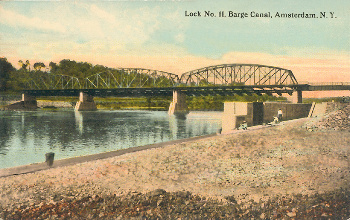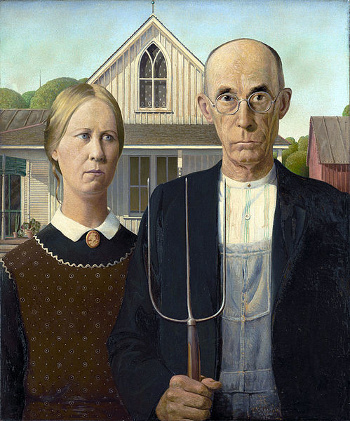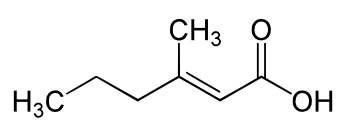Bacterial Signature
November 12, 2015
Upstate New York, where I spent the early years of my life, is a vast
forest occasionally punctuated by a small
town or
city. The larger cities of Upstate developed along the
Erie Canal, a 584
kilometer waterway that links the
Hudson River at
Albany to
Lake Erie at
Buffalo. The only way such a waterway can function is by a system of
locks that controls the
flow of
water through a
differential elevation of about 172
meters. The canal opened in 1825.

A 1912 engraving of Lock No. 11, at Amsterdam, New York, of the Barge (née Erie) Canal.
(Via Wikimedia Commons.)
The Erie canal was an
innovation and an
engineering marvel at its time. Just as today, when the
automobile has inspired many useful
technologies, waterway transportation did the same in its era.
American engineer,
Robert Fulton (1765-1815), was inspired by the
Watt steam engine of the late
18th century to construct the first commercially successful
steam-powered boat in 1807. I wrote about steam power in a
previous article (Steam Power, January 28, 2011).
This boat, the
Clermont, carried passengers between
New York City and Albany. Although it was a success, it was initially called "Fulton's Folly." This characterization was apt for steam engines of the time, which had a likelihood of
exploding. As recalled in a recent story in the
Pittsburgh Post-Gazette,
Charles Dickens and his
wife were uneasy about steam travel during their 1842 visit to
Pittsburgh, but they were advised that steamboats fitted with a
pressure relief valve were considered safe.[1]
During my
childhood, I lived in
Utica, New York, one of the cities along the Erie Canal. A trip of just a few miles in any direction would lead off into the wilderness. One wilderness adventure for our
family was a trip to the
Catskill Game Farm, which, despite the name, was actually a
zoo. What do I remember most about this zoo? It's the
odor.
It's not the the staff was negligent in its responsibilities. It's just that
bacteria feed from both the input and output streams of
animal life, and there are multiple sources for bacterial infiltration in a zoo, such as
food,
feces, and
urine. Perhaps I exaggerate, but you could turn off your
GPS within a
mile of a zoo and still find your way. This is much more of a problem with
industrial farming, such as
pig and
poultry farms.
An article in
Modern Farmer magazine states that there are more than 200
chemical compounds in
swine odor, which includes such notables as
ammonia,
hydrogen sulfide, and a mixture of
organic compounds that smells like
rotting flesh.[2] Poultry farms emit 60-150 odoriferous compounds, such as "
volatile fatty acids,
mercaptans,
esters,
carbonyls,
aldehydes,
alcohols, ammonia, and
amines."[3]

American Gothic (oil on beaver board, 1930) by Grant Wood (1891-1942)
The number of farms in the US peaked at 7 million in 1935. There are just 1.9 million remaining, but with nearly the same total acreage as at the peak.
(From the Friends of American Art Collection of the Art Institute of Chicago, via Wikimedia Commons.)
Humans are animals, too, and a quick look around a
supermarket or
pharmacy will show that we're very concerned about
our odor. Some odors are beneficial, like the sex-attractant
pheromones,[4] and there are a variety of
perfumes and
colognes that attempt to mimic their attractive properties. For the unpleasant odors, we at first resort to
soap, and then to things like
antiperspirants, and aptly named "deodorants."
Antiperspirants contain chemical compounds, notably
aluminum chlorohydrate, that slow the rate of
perspiration. This has a beneficial effect, since underarm odor comes from bacterial action on
human sweat, with the armpit area being a nice warm environment for bacterial growth. The chemical,
trans-3-Methyl-2-hexenoic acid, is the principal component of body odor.

Trans-3-Methyl-2-hexenoic acid
(Wikimedia Commons image.)
Not all body odor is bad. In fact, there are subtle differences in the scent of a person; and, as shown by
experiment, individuals can be identified by their scent. In one study, 100% of
women tested were able to identify their
newborn babies by scent after an hour or more exposure to the
infants.[5]
While most odors are a second-order effect caused by bacteria, today's
technology makes it possible to analyze small quantities of bacteria themselves. This leads to the possibility that individuals might have a traceable bacterial "signature." That's the idea tested by scientists at the
University of Oregon (Eugene, Oregon) and the
Santa Fe Institute (Santa Fe, New Mexico). They found that occupied spaces have a microbial signature distinct from unoccupied spaces, and that individuals have a personalized microbial
aura.[6-7]
Says lead author,
James F. Meadow, who conducted this research while a
postdoctoral researcher at the University of Oregon,
"We expected that we would be able to detect the human microbiome in the air around a person, but we were surprised to find that we could identify most of the occupants just by sampling their microbial cloud."[7]
Bacteria associated with individuals are
dispersed into the
environment through direct contact and by
bioaerosol particle emission from
breath,
clothes,
skin and
hair.[6] Humans shed about a million particles of size less than 0.5
micrometer every hour, many of which would contain bacteria.[6]
In their experiments, the University of Oregon researchers sampled microbes from the air space of a single person sitting in a
sanitized environmental chamber, and they compared that to air sampled in an adjacent, identical, unoccupied chamber.[6] They used high-throughput
DNA sequencing methods to characterize the airborne bacteria.[6] In subsequent, higher resolution, experiments they sampled 8 different people for 90 min each with air flowing through a
collection filter at on and three air change per hour.[6]
Individuals could be distinguished through their airborne emissions in the chamber within 1.5-4 hours.[6] They authors comment that their experiments might help to understand the mechanisms involved in
infectious disease transmission in buildings.[7] At this point, considerable time is involved in detection, but there might be potential
forensic applications.[7] Perhaps the
surveillance society might be worse than we imagined.
References:
- Len Barcousky, "Eyewitness 1842: Dickens finds Pittsburgh full of smoke and fires," Pittsburgh Post-Gazette, August 30, 2015.
- Christopher Weber, "Stink Wars: When a Foul Wind Wafts From a Farm, Is it a Problem?" Modern Farmer, January 27, 2014.
- John P. Chastain, "Odor Control From Poultry Facilities," Chapter 9 of Poultry Training Manual, Clemson Cooperative Extension.
- Napoleon supposedly wrote in a letter to Josephine, Ne te lave pas. Je reviens. (Don't bathe. I'm coming home.)
- M. Kaitz, A. Good, A. M. Rokem, and A. I. Eidelman, "Mothers' recognition of their newborns by olfactory cues," Developmental Psychobiology, vol. 20, no. 6 (November, 1987), pp. 587-591.
- James F. Meadow, Adam E. Altrichter, Ashley C. Bateman, Jason Stenson, GZ Brown, Jessica L. Green, Brendan, and J.M. Bohannan, "Humans differ in their personal microbial cloud," Peerj, vol. 3, Document No. e1258 (September 22, 2015), DOI: 10.7717/peerj.1258.
- New research finds that people emit their own personal microbial cloud, Peerj PressRelease, September 22, 2015.
Permanent Link to this article
Linked Keywords: Upstate New York; forest; town; city; Erie Canal; kilometer; waterway; Hudson River; Albany, New York; Lake Erie; Buffalo, New York; lock (water transport); flow; water; differential elevation; meter; Amsterdam, New York; New York State Canal System; Barge Canal; Wikimedia Commons; innovation; engineering; automobile; technology; technologies; American; engineer; Robert Fulton (1765-1815); Watt steam engine; 18th century; steamboat; steam-powered boat; Clermont; New York City; explosion; exploding; Pittsburgh Post-Gazette; Charles Dickens; wife; Pittsburgh; pressure relief valve; childhood; Utica, New York; family; Catskill Game Farm; zoo; odor; bacteria; animal; food; feces; urine; Global Positioning System; GPS; mile; intensive farming; industrial farming; pig; poultry; Modern Farmer magazine; chemical compound; domestic pig; swine; ammonia; hydrogen sulfide; organic compound; decomposition; rotting flesh; volatile organic compound; fatty acid; thiol; mercaptan; ester; carbonyl; aldehyde; alcohol; amine; oil paint; beaver board; Grant Wood (1891-1942); acreage; Art Institute of Chicago; human; supermarket; pharmacy; body odor; pheromone; perfume; cologne; soap; deodorant; antiperspirant; aluminum chlorohydrate; perspiration; human sweat; trans-3-Methyl-2-hexenoic acid; experiment; woman; newborn baby; infant; University of Oregon (Eugene, Oregon); Santa Fe Institute (Santa Fe, New Mexico); aura; James F. Meadow; postdoctoral research; dispersion; disperse; environment; bioaerosol; breathing; breath; clothing; clothes; skin; hair; micrometer; disinfectant; sanitize; environmental chamber; DNA sequencing; air filter; collection filter; infection; infectious disease; epidemiology; transmission; forensic; surveillance society.